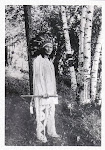Dr. Charles Alexander Eastman – Ohiyesa -- stands as one of the most remarkable individuals of the late 19th and early 20th Century, whose legacy of writings and works remain powerful over a half century after his death. He bridged cultural divides and earned the respect of Native Americans and the general population, challenging both to higher standards of thought, action, and contributions to the nation. As a best-selling author and lecturer, he was the most recognized American Indian of his time and was highly influential in the progress of American Indians toward civil rights and self-determination.
His name, Ohiyesa, a Dakota (Sioux) name, was like the brush of swift wings to the national ear, unfamiliar and startling. It was a name that discomfited eight inhabitants of the White House and excited the nation’s youth. Ohiyesa means the One Who Wins, not just “Victor” in a single contest, but one continually striving and in the final count, achieving. This is the story of Ohiyesa, Dr. Charles Alexander Eastman.
Like Barack Hussein Obama, Charles Alexander Eastman rose unexpectedly to national stature, as cream in a country frothing with contradictions within the milk of American “civilization.” Eastman first stepped out from the shadows of stereotypes into the nation’s limelight in the 1890s when he told of his Dakota youth in magazines and then in his memoir Indian Boyhood (1894):
“What boy would not be an Indian for a while
when he thinks of the freest life in the world?”
Contrary to America’s stereotypes, his “savage” life was not Godless, brutal, haphazard, bestial, or sappily “noble.” He had not defeated armies in battle, like Sitting Bull or Crazy Horse, nor led famous raids like Geronimo or Tecumseh. He hadn’t dazzled audiences with death-defying rides with Buffalo Bill’s Wild West Show or been sentimentalized in poetry like Hiawatha. Instead he had been formally trained by his family and Dakota band for three vocations: as a healer, as a storyteller/historian, and as a defender of his people. These goals were the emotional and philosophical framework he carried within him, and without an understanding of the internal landscape of his Dakota education, one can not grasp the complex person he was, the conflicts he faced, and the true nature of his achievements.
Eastman told America in his own words about a youth that was both “free” and carefully directed in a formal community education system. Spirituality and the virtues of honesty, respect, generosity, courage, duty, and adventure imbued all aspects of his Dakota training, qualities America worried its own young people were losing. Suddenly, youth groups, schools, and summer camps scrambled to integrate pan- Indian elements into their programs, and Eastman was their consultant. Long before contemporary fitness trends, Dr. Eastman led a movement to develop outdoor education camps based on Indian physical training, games, and woodcraft – taking a formative role in the 1910 creation of the Boy Scouts of America and Camp Fire Girls, and of YMCA Indian Scouts. Through his many articles, books, speeches, and camps, he turned “savage” from a slur into an educational aim.
His lasting contributions to the nation, though, extend far beyond his youth work. As a physician and author, he improved medical care on reservations, co-founded the Society of American Indians, and stood up for nearly forty years as an advocate for Indian rights to Congress and presidents. With the editorial and secretarial assistance of his wife, Elaine Goodale Eastman, Charles wrote more than ten best-selling books and traveled on domestic and international speaking tours, emphasizing respect and understanding between people of different cultures. He developed friendship with other writers of American classics such as Ernest Thompson Seton, Hamlin Garland, and Mark Twain. Eastman's books have remained in print for more than 100 years, still being read and consulted in many editions. His advocacy, along with other educated American Indian colleagues, led to the "New Deal for the American Indian" -- the citizenship, self-determination, and religious rites and language protection bills of FDR's Administration.
Friday, July 24, 2009
Subscribe to:
Post Comments (Atom)





No comments:
Post a Comment